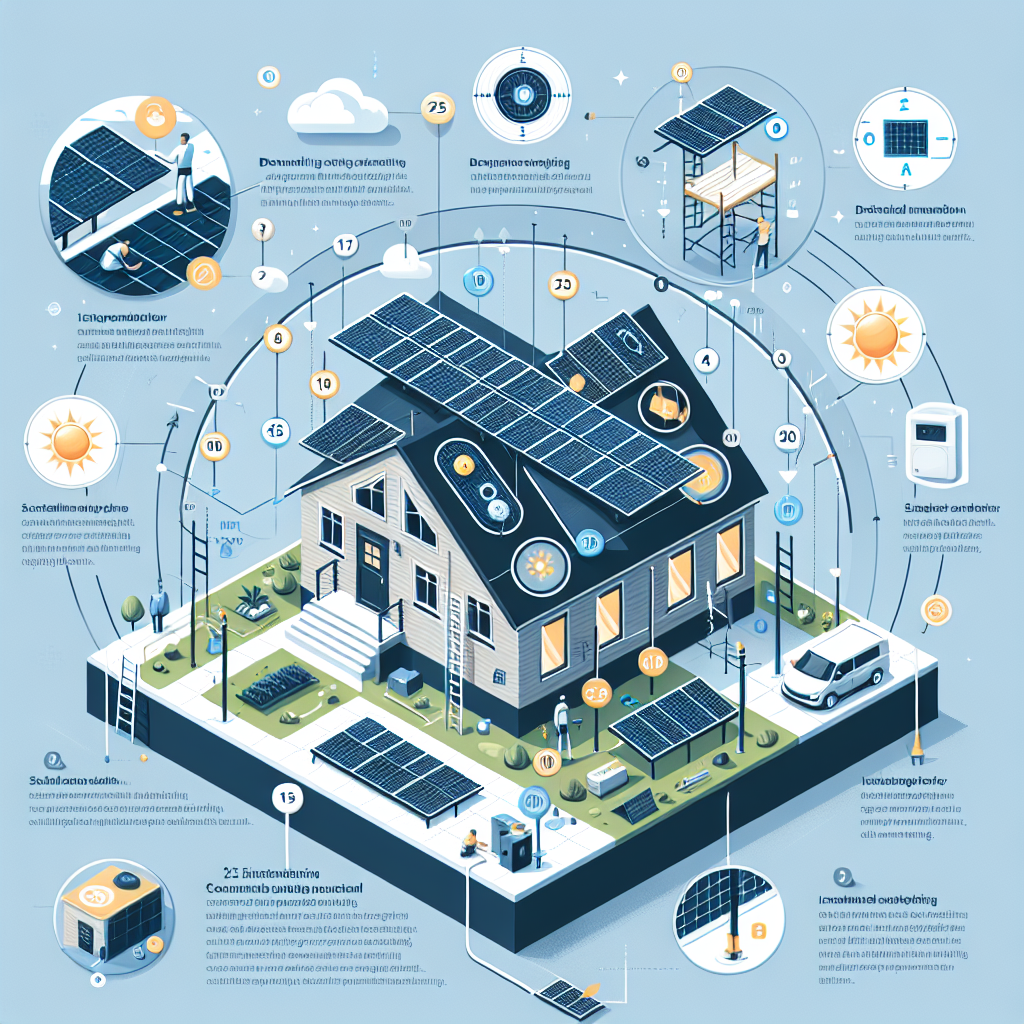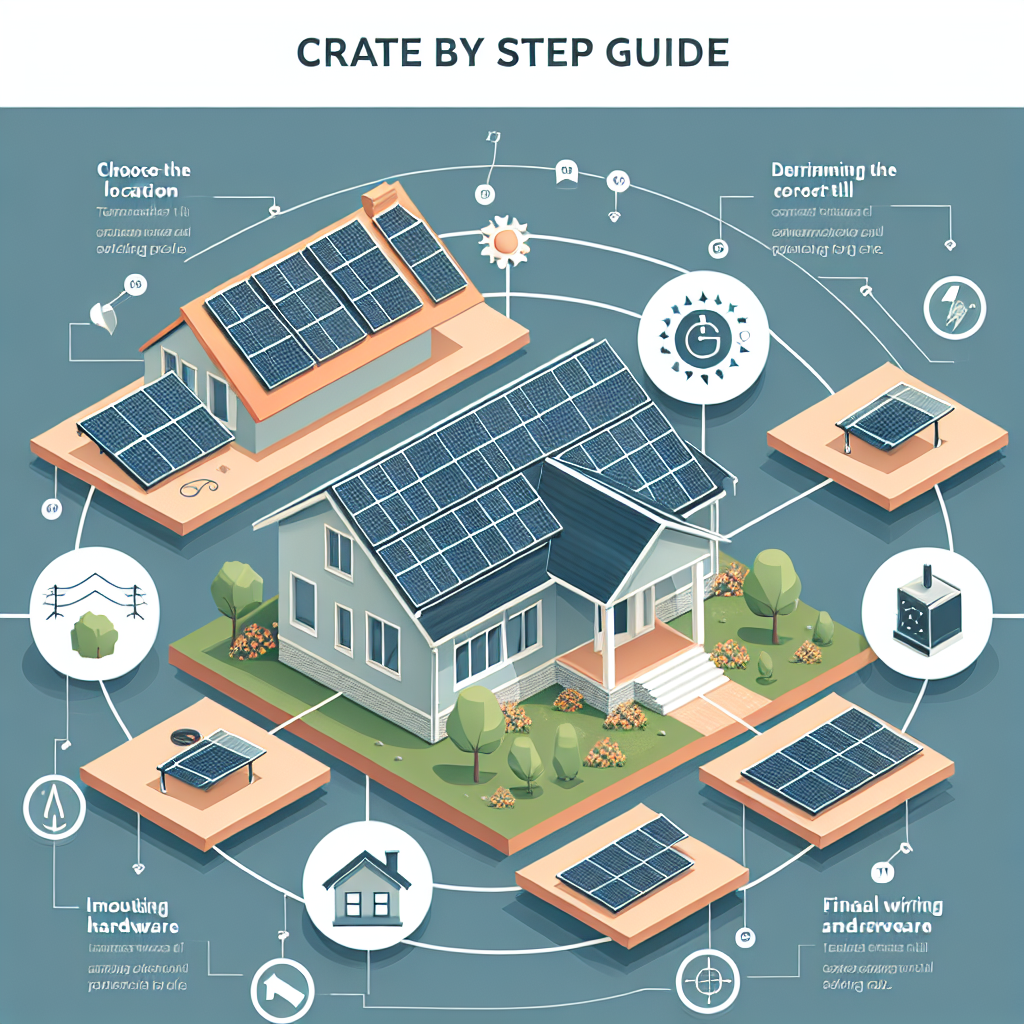How To Install Solar Panels
As an Amazon Associate, I earn from qualifying purchases, at no additional cost to you. Disclaimer
Ready to harness the power of the sun and save some money on your energy bills? Look no further! In this article, I will guide you through the process of installing solar panels, making it easier than ever to embrace renewable energy. From finding the perfect location to securing the panels in place, I’ve got you covered. So grab your tools and let’s get started on this exciting journey towards a cleaner and more sustainable future!

Understanding Solar Energy
What is Solar Energy?
Solar energy is a renewable and sustainable form of energy that is harnessed from the Sun. It is a clean source of power that does not produce any harmful emissions or pollution. Solar energy is becoming increasingly popular as it offers an alternative to traditional energy sources and helps reduce the carbon footprint.
How do Solar Panels work?
Solar panels, also known as photovoltaic (PV) panels, work by converting sunlight into usable electricity. They consist of small devices called solar cells, which are made of semiconductor materials such as silicon. When sunlight hits these solar cells, it knocks electrons loose from their atoms, creating an electric current. This direct current (DC) is then converted into alternating current (AC) by an inverter, making it compatible with the electrical appliances in your home.
Advantages of Solar Energy
There are numerous advantages to using solar energy. Firstly, it is a sustainable and renewable source of energy, meaning that it will never run out. Additionally, solar energy is clean and helps reduce greenhouse gas emissions, making it an eco-friendly option. Installing solar panels can also lead to significant cost savings on electricity bills over time. Moreover, solar panels require very little maintenance and can even increase the value of your property. Overall, solar energy offers a reliable and efficient solution for meeting your energy needs while protecting the environment.
Planning Your Solar Installation
Assessing your energy needs
Before installing solar panels, it is crucial to assess your energy needs. Evaluate your current electricity consumption by reviewing your past utility bills. This will help you determine how many solar panels you will need to generate enough electricity to meet your needs. Consider factors such as the size of your home, the number of occupants, and the energy requirements of your appliances.
Choosing the right solar panels
When choosing solar panels for your installation, it is important to consider factors such as efficiency, durability, and warranty. Look for panels that have a high efficiency rating, as this will determine how effectively they can convert sunlight into electricity. Additionally, consider the warranty offered by the manufacturer to ensure that you are protected in case of any defects or issues with the panels.
Knowing your local laws and regulations
Before installing solar panels, it is essential to familiarize yourself with the local laws and regulations regarding solar energy. Some areas may have specific permits or zoning requirements that need to be followed. Research the policies and guidelines set by your local government or utility provider to ensure compliance and to avoid any potential legal issues in the future.
Obtaining necessary permissions
Once you are aware of the local laws and regulations, it is time to obtain the necessary permissions for your solar installation. This may involve applying for permits and approvals from your local authorities or homeowner’s associations. Be sure to submit all the required documentation and follow the proper procedures to ensure a smooth and hassle-free installation process.

Choosing the Installation Site
Solar panel positioning and sunlight exposure
Selecting the optimal location for your solar panels is crucial for maximizing their efficiency. The panels should be installed in an area that receives ample sunlight throughout the day. Ideally, the panels should face south, as this orientation captures the most sunlight. Avoid shading from trees, buildings, or other obstructions that may block the sunlight and reduce the panel’s productivity.
Roof top vs ground installation
When deciding between a roof-mounted or ground-mounted installation, consider factors such as available space, aesthetics, and ease of installation. Roof-mounted systems are a popular choice as they utilize existing space and can be integrated seamlessly into the building’s structure. Ground-mounted systems may be more suitable if you have ample land available or if your roof is not suitable for solar panel installation.
Evaluation of structural integrity of roof
Before installing solar panels on your roof, it is important to assess its structural integrity. Engage a professional to ensure that your roof can support the additional weight of the solar panels. They will inspect the roof and determine if any repairs or reinforcements are needed. Ensuring a sturdy and stable roof is essential for the long-term performance and safety of your solar panel system.
Avoiding shading for maximum efficiency
Shading can have a significant impact on the efficiency of your solar panels. Even a small amount of shade can drastically decrease the power output. It is important to identify and avoid potential shading issues during the installation process. Trim branches, relocate obstructions, or consider alternative panel placements to ensure optimal sunlight exposure and maximize the efficiency of your solar panel system.
Components of Solar Panel System
Description of solar panels
Solar panels consist of numerous solar cells grouped together in an interconnected network. These solar cells are usually made of silicon, which is a highly efficient and durable semiconductor material. The panels are framed and covered with a layer of glass to protect the solar cells from external elements. Each solar panel generates a certain amount of electricity depending on its size, efficiency, and the amount of sunlight it receives.
Understanding inverters
Inverters are an essential component of a solar panel system as they convert the direct current (DC) produced by the solar panels into alternating current (AC) that can be used to power electrical appliances. There are two main types of inverters: string inverters and microinverters. String inverters are connected to multiple panels in a series, while microinverters are installed on each individual panel. Each type has its advantages and factors to consider when selecting the most suitable inverter for your solar installation.
Solar batteries explained
Solar batteries store excess electricity generated by the solar panels for later use. They are typically used in off-grid systems or as backup power during grid outages. Solar batteries allow you to store the excess energy produced during the day and use it at night or during low sunlight periods. They provide greater independence from the power grid and can help maximize the utilization of the solar energy generated by your system.
Introducing charge controllers
Charge controllers regulate the amount of current flowing from the solar panels to the batteries. They prevent overcharging and ensure that the batteries are charged efficiently and safely. Charge controllers come in different types, including pulse-width modulation (PWM) and maximum power point tracking (MPPT). Depending on the size and configuration of your solar panel system, the appropriate charge controller should be selected to optimize the charging process and protect the batteries.

Acquiring Your Solar Panel Hardware
Where to buy solar panels
Solar panels can be purchased from various sources, including manufacturers, distributors, and reputable retailers. Research different suppliers and compare prices, warranties, and customer reviews before making a purchase. It is also advisable to consult with professionals or experienced solar installers who can provide recommendations based on your specific requirements and budget.
Understanding Panel specifications
When buying solar panels, it is important to understand the specifications provided by the manufacturer. These specifications include the panel’s wattage, efficiency, temperature coefficient, and warranty. Wattage refers to the power output of the panel, while efficiency indicates how effectively it can convert sunlight into electricity. The temperature coefficient reveals how the panel’s performance is affected by changes in temperature. Carefully review and compare these specifications to ensure that you select the most suitable panels for your installation.
Selecting inverters and batteries
In addition to solar panels, you will need to select inverters and batteries for your solar panel system. Consider factors such as the power output, efficiency, compatibility, and warranty when choosing these components. Consult with experts or professionals to determine the most suitable inverters and batteries that align with your specific requirements and budget.
Mounting hardware and wiring
Acquire the necessary mounting hardware and wiring for your solar panel installation. The mounting hardware includes racks, brackets, and clips that secure the panels to the roof or ground. Ensure that the mounting hardware is appropriate for your specific installation site and requirements. Additionally, purchase the required wiring and connectors to connect the solar panels, inverters, batteries, and charge controllers into a cohesive and efficient system.
Installing the Solar Panels
Mounting the solar panels
To install the solar panels, begin by attaching the mounting hardware to the roof or ground. Follow the manufacturer’s instructions and ensure that the panels are securely fastened. Take into account the proper orientation and angles to optimize sunlight exposure. Carefully place each panel on the mounting hardware and secure them in place, ensuring that they are evenly spaced and aligned.
Securing and grounding the solar panel system
After mounting the solar panels, it is crucial to secure and ground the entire system. This involves properly fastening the panels to the mounting hardware to prevent movement or damage due to strong winds or other environmental factors. Additionally, ensure that the system is adequately grounded to protect against electrical hazards and provide safety during maintenance or repairs.
Wiring the solar panels
Once the solar panels are mounted and secured, it is time to connect them to the rest of the system. Begin by running the necessary wiring from the panels to the inverter location. Carefully route and secure the wiring to ensure it is protected and hidden when possible. Follow the manufacturer’s instructions and consult with professionals if needed to ensure proper wiring and connections.

Installing the Inverter
Choosing the location for inverter
Select an appropriate location for installing the inverter. It should be easily accessible, well-ventilated, and away from direct sunlight exposure or extreme temperatures. Consider factors such as noise levels and potential wiring distances when deciding on the optimal location for the inverter. Consult the manufacturer’s guidelines and recommendations for the specific inverter model you have selected.
Installing and connecting the inverter
To install the inverter, follow the manufacturer’s instructions and guidelines. Mount the inverter securely on the chosen location, making sure it is level and adequately supported. Connect the DC and AC wiring from the solar panels and the electrical panel to the appropriate terminals on the inverter. Ensure proper connections and cable management to avoid any potential hazards or performance issues.
Grounding the inverter
Grounding the inverter is an important safety consideration. Connect the inverter to the grounding system of your home or building according to local electrical codes and regulations. Proper grounding protects against electrical faults, ensures the safety of the system, and provides a pathway for electrical currents in the event of a fault or surge.
Setting up the Solar Battery System
Choosing the location for batteries
For systems that include solar batteries, choose a suitable location for the batteries. The location should be well-ventilated, away from extreme temperatures, and easily accessible for maintenance and inspections. Follow the manufacturer’s guidelines and recommendations regarding the specific battery model you have selected.
Connecting the batteries to the system
After selecting the location, connect the solar batteries to the rest of the system. Follow the manufacturer’s instructions for proper wiring and connection. Ensure that the batteries are connected in the correct series or parallel configuration, as specified. Take necessary precautions to avoid short circuits and ensure the safety of the system.
Ensuring proper ventilation for batteries
Solar batteries produce heat when charging and discharging. It is important to provide adequate ventilation to dissipate the heat and prevent any damage or reduced performance. Ensure that there is sufficient space around the batteries and install ventilation fans if required. Regularly inspect the batteries and monitor their temperature to ensure they are operating within the recommended range.

Connecting to the Power Grid
Understanding grid-tied systems
Grid-tied solar systems allow you to connect your solar panel system to the power grid. This setup allows for the export of excess electricity generated by your solar panels to the grid, while also allowing you to draw power from the grid when needed. It provides the flexibility of utilizing renewable energy and reducing electricity costs while having access to grid power as a backup.
Installing a bi-directional meter
To connect to the power grid, you will need to install a bi-directional meter. This meter measures the electricity imported from or exported to the grid. It enables you to keep track of the energy consumed from the grid and the excess energy fed back into the grid. Contact your utility provider to coordinate the installation of the bi-directional meter and ensure compliance with their policies and procedures.
Interfacing solar system with power grid
To connect your solar system to the power grid, it is necessary to install an inverter that allows for synchronization with the grid. This inverter ensures that the electricity generated by the solar panels is in phase with the grid’s voltage and frequency. Hire a professional electrician or consult with experts to properly configure the inverter and ensure smooth and safe integration with the power grid.
Maintenance of Solar Panel System
Cleaning the solar panels
Regular cleaning of the solar panels is important to maintain their efficiency and performance. Remove dust, dirt, and debris from the panels using a soft cloth or a gentle stream of water. Avoid harsh chemicals or abrasive materials that may damage the panels. Clean the panels at least once a year or as needed, particularly in dusty or polluted areas. Regular cleaning will help ensure optimal sunlight absorption and maximize electricity generation.
Regular system checks
Perform regular checks of your solar panel system to ensure that it is functioning correctly. Monitor the production of electricity and compare it with your energy needs to identify any discrepancies or potential issues. Inspect the wiring, connections, and components for signs of damage or wear. Check for any shading or obstructions that may have appeared over time and take appropriate action to remedy the situation.
Troubleshooting common issues
In the event of any issues or problems with your solar panel system, it is important to troubleshoot the cause and take appropriate action. Common issues may include wiring faults, inverter malfunctions, or reduced panel performance. Follow the manufacturer’s troubleshooting guide, consult online resources, or seek professional assistance to identify and resolve any issues promptly.
When to call a professional for maintenance
While regular maintenance can be performed by homeowners, it is advisable to engage a professional for more complex maintenance tasks or in case of significant issues. Professionals have the expertise and knowledge to diagnose and address any problems effectively. They can also provide routine maintenance services, such as system inspections, cleaning, and performance optimization, to ensure the long-term reliability and efficiency of your solar panel system.
In conclusion, understanding solar energy and the installation process is essential for harnessing the benefits of solar power. By carefully planning, selecting the right components, and following proper installation and maintenance procedures, you can create a reliable and efficient solar panel system that will provide clean and sustainable energy for years to come.

